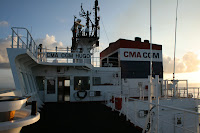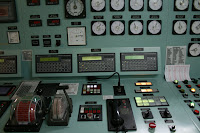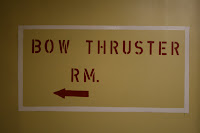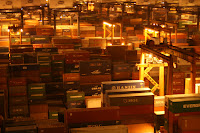
The next time you pop down the shops, it’s a good bet that some of the items that end up your bag have once been on a boat.
Whilst humans can whizz through the air, care of Boeing and Airbus, most of the things we buy from aboard stay firmly on the ground. Or at least, the water.
Ninety percent of the world’s trade is carried by sea, loaded up on massive container ships and floated across oceans and seas.
The CMA-CGM Hugo is one of these such ships.
Yet calling him a ‘ship’ is to belittle him. He‘s (for surely with a name like that one must break with the convention of making all ships female and address him as such) much more than a ship.
A behemoth, a big beast, a key part of the machine.
Built in a Korean shipyard the Hugo entered service five years ago, one of the largest of his kind.
Standing 62m tall and measuring over 1,000 foot long, he weighs in at a hefty 90,000 tonnes.
Standing 62m tall and measuring over 1,000 foot long, he weighs in at a hefty 90,000 tonnes.
With a draft of 48 feet when fully loaded, and 140 feet wide (just enough to squeeze through the Panama Canal) he is a true titan of the oceans.
This appearance is not deceptive, for he packs a mighty punch as well.
Down in the engine room the impressive Hyundai engine is a huge metal monster, all pistons and pipes, exhausts and flashing lights. It‘s capable of producing 93,000 horsepower - enough to turn the propeller at up to 94 rpm and push the boat along at speeds of up to 26 knots/hour.
Pretty impressive for such a heavy craft.

This is thirsty work of course, at Hong Kong we took in a mere 5,500 metric tons of heavy diesel, enough to power the big fella across the Pacific to LA and back. That’s a fair few barrels of the black stuff, yet still far more fuel efficient than an aeroplane.

This is thirsty work of course, at Hong Kong we took in a mere 5,500 metric tons of heavy diesel, enough to power the big fella across the Pacific to LA and back. That’s a fair few barrels of the black stuff, yet still far more fuel efficient than an aeroplane.
All this power of course is with one purpose in mind - to carry our precious cargo across an ocean.
And the cargo itself is no less impressive. From the bridge it lies stretched out, nine rows to the bow, another five rows astern. Big heavy 40 foot containers, rust and rocking in the swell, nine across and five deep.
Below, in the holds, lie another nine layers of containers, of equal proportions.
Below, in the holds, lie another nine layers of containers, of equal proportions.
This all adds up to a maximum capacity of some 8,200 containers (though, thanks to recent global economic jitters we’re only stacked up to about three quarters capacity).
It’s hardly surprising then that a huge heavy lifting operation swings into action each time one of those vessels hoves into view over the horizon.
The containers resemble massive, rusting lego bricks, green, red, yellow, blue. They’re stamped with their companies names: Maersk, Hapag-Lloyd, Hanjin, MSC. Unfamiliar names carrying familiar brands.
We don’t know exactly what’s inside, but we can hazard a guess. Consumer items from the factories of China to the living rooms of America. TVs and ipods, cheap clothes and food.
I’m told this tub is so big it can carry enough cargo to completely fill a shopping centre of one million-square-feet, stacking the shelves some eight feet high. That’s a lot of Christmas presents.
The Hugo is a modern marvel, a testament to the engineering brilliance of mankind and his capacity for logic and organisation.
The Hugo is a modern marvel, a testament to the engineering brilliance of mankind and his capacity for logic and organisation.
And, statistics aside, he’s a living, breathing symbol of the interconnected, interdependent, inexorable nature of global trade today.
You don’t need a credit crunch to realise how reliant countries are on each other for the goods that make them tick. Just take a look around Hugo: his various parts and machinery, his crew and destinations.
Consider his multinational character: Korean-built, French-owned, German-run, serving the peoples of China, America and probably way beyond. This makes him the maritime equivalent of a Hollywood movie, key components coming from different countries.
And scan his cargo inventory, with products made, originating from, or heading to, a whole host of other nations. 
He may fly a German flag but surely he belongs to the world.

He may fly a German flag but surely he belongs to the world.
Running the Hugo requires a compliment of 8 officers (German and Polish) and 16 crew (all Filopino), surprisingly few for so large a vessel.
These men are extremely busy for, alongside manning the bridge and guiding it across the ocean, the vessel demands constant attention and endless maintenance.
Oiling and welding, washing and cleaning, Safety checks, firedrills, equipment checks, it goes on and on.
There’s a crew to be fed, and cargo to be checked, records to be kept and mountains of paperwork to attend to.
It’s a 24-hour job, with the crew rotating in shifts, long nights on the bridge, watching the screens, or in the heat of the engine room, monitoring banks of bewildering dials.
All’s ship-shape and tightly-run, working to local time, following the 24 hour clock and keeping rigorously to schedule.
Safety is paramount, fire the greatest fear. Safety checks are made day and night,; warning signs de riguer; checklists are exhaustive, neatly painted yellow and black stripes mark out every possible trip hazard.
The Hugo runs the ‘Pearl River Express’ route, between the southern coast of China and the West coast of the USA. Trade between these two countries is increasing faster and faster and boats such as this are its workhorses, powering this growth.
Before boarding we realised the significance of the shipping business, however it wasn’t until we were on board that we came to realise just how big a piggy bank it was upon which we had hitched a ride.
This is a multi-billion pound industry - the sums of money involved are mind boggling. In California, our destination, the value of international trade to California tops $350 billion every year. If the Hugo went down he would take tens, if not hundreds of millions of dollars with him.
Hugo is one of many container ships; CMA CGM (his French owners) alone own or have on order 17 of this class of vessel.
This may sound rather extravagant but then they do boast quite a considerable turnover - last year, for example, their revenue stood at some $11.8 billion.
Money aside, perhaps these shipping lines are of even greater significance. The Hugo and others are witnesses to the shifts in the global economy, carriers of change as China expands and others follow in its wake.
He’s websites and restaurants and supermarket shelves. He’s factories, clothes shops and online retailers.
See, much more than a ship.
Read more...




































